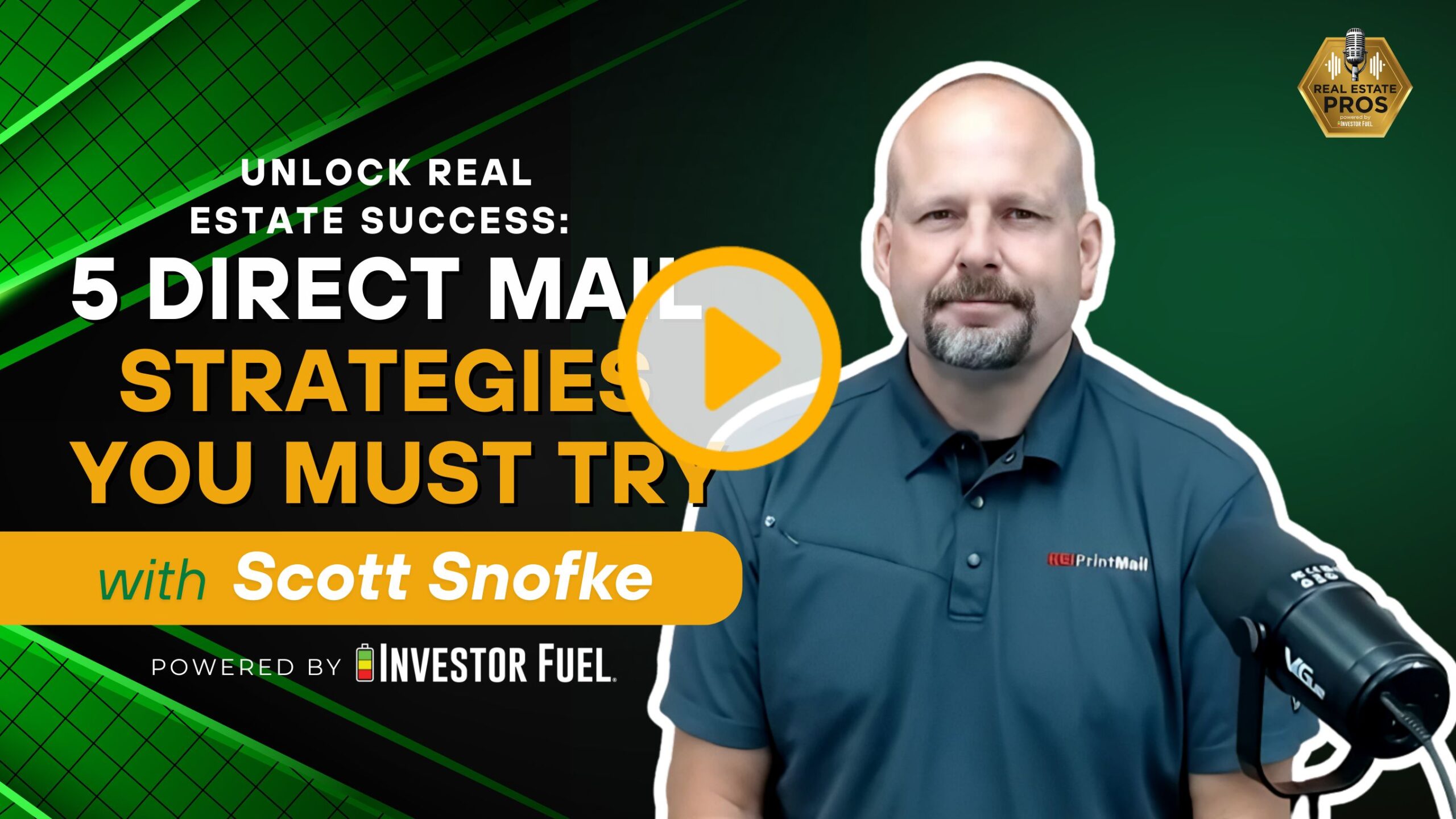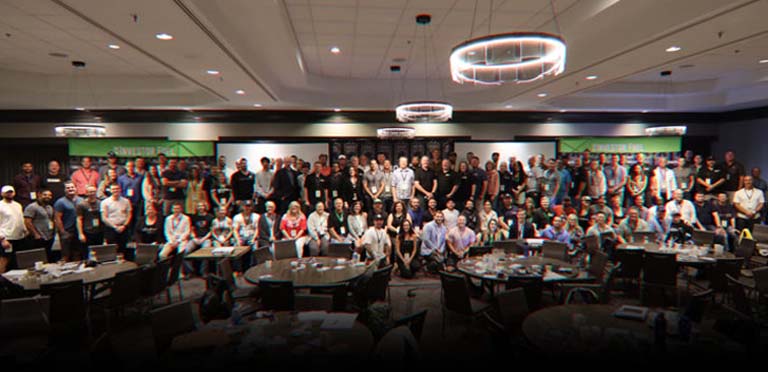
Show Summary
In this episode of the Investor Fuel podcast, host Michelle Kesil speaks with Scott Snofke from REI Printmail about innovative strategies in direct mail marketing for real estate. Scott emphasizes the importance of tracking key performance indicators (KPIs) to optimize marketing efforts and ensure client success. He shares insights on the challenges of data management in real estate, the effectiveness of direct mail in generating leads, and the significance of building strong client relationships. The conversation highlights the need for a customer-centric approach and the value of personalized service in the industry.
Resources and Links from this show:
Listen to the Audio Version of this Episode
Investor Fuel Show Transcript:
Michelle Kesil (00:01.486)
Hey everyone, welcome to the Investor Fuel podcast. I’m your host, Michelle Kesil, and today I’m joined by someone I’ve been looking forward to chatting with, Scott Snufke, who’s been making serious moves in the printing and real estate space. So Scott, I’m really glad to have you here.
I think our listeners are really going to take something away from how you’re approaching your business. So let’s dive in. First off, just for people who are not familiar with your world yet, would love to hear the short version of what your main focus is these days.
Scott Snufke (00:47.823)
So we’re with REI Printmail. You know, the thing that really sets us apart inside of the industry is we’re tracking everything we do. We kind of have a done for you service. as a senior direct marketing coach, I sit down with a potential client that’s looking for real estate investment properties throughout the nation. And I walk them through how to pull a list, what, you know, how to cultivate that list into finding the targets that they want, whether it’s through one of our data sets or
even their data sets. have our hands at about 15 different data sets across the nation. And we track the KPIs through our direct mail. And how we do that is with one, call center will screen and filter, and then that feeds back into the KPI tracking. So we know what’s a qualified lead, how many inbound calls we have, how many of those were first time callers, and we can sit back and analyze what the mail is doing and also what the list is doing. So we can track
you know, multiple list providers at one time, can track multiple different pieces of mail at one time to know what’s going to generate the best response in the area. And then we just help our clients just walk through as an extension of their marketing department to, you know, find where’s what’s working where. This is a pretty simple answer to that.
Michelle Kesil (02:03.788)
Yeah. And are there any specific markets that you’re operating in?
Scott Snufke (02:09.055)
We’re coast to coast, you know nationwide we cover, you know, the continental US Alaska and Hawaii You know and then what we can do with that is since we are covering those areas We we know prior to what they’re currently, you know responding to what style of list and then even if we’re Getting into the list of you know, we’ll subdivide that list into if you’re looking for flips You’re looking for buying holds, you know, you’re you’re looking for wholesale deals or whole tail or listings
you know, can cultivate that list to fit the parameters of those styles of disposition.
Michelle Kesil (02:44.77)
Yeah, love that. So what caught my attention was about the way that you’ve been able to create something different in the industry and unique for the clients, whether that’s like this new metric with your lists and the managing of the multiple markets, which is not easy. So I would just love to hear how you’ve been managing to keep that machine really running smoothly.
Scott Snufke (03:11.087)
That’s I mean it all comes down to KPIs. They’re simply the lights inside of the industry. If you walk through your house in the dark you’re going to stub your toes step on something. If you turn the lights on you’re going to be able to maneuver in and out of your house or subject to other markets. You’re to be able to maneuver in and out of those by knowing one what’s working what they’re responding to what style of properties the demographics of the properties you’re targeting. By cultivating that first list of targets.
you know, the better that is, the better that’s going to create your response rate. And we’re using several different levels of AI to generate, to make sure that we can pull a wider list, find the parameters that other people potentially are missing, and then let the AI bring it back into a targeted list to find who’s more likely to sell. You know, so then we can have it score data and, you know, make it a little bit more efficient because, you know, there’s nothing more expensive than direct mail done wrong.
They can get you know, very pricey very fast So what we try to focus on is is you know by utilizing the KPIs we know what’s working and we take that into your market to repeat that process and then we Continue to track that and tweak and tune say hey, you know this zip code here is really working really well finding your properties zip this zip codes not so let’s remove that, know, so we can pivot pretty quickly and
you know, move in and out of that particular market to help them. And then also we help people find other markets if they’re going virtual. Does that help?
Michelle Kesil (04:41.58)
Yeah, absolutely. Thanks for sharing. Now, I know that in business there’s always moments where things get real, maybe something went sideways or you had to pivot fast. Would you mind sharing one of those moments for you?
Scott Snufke (04:58.019)
Well, I mean, one of the things inside of what we do with our owner, Jeff Charlton, is we’re customer based. know, one, if you call us, you’re going to speak to a live person. You’re not going to get a VA overseas or, you you’re not going to be dropping in your list and doing all of that stuff yourself. You’re going to be sending me the list or sending my project manager the list. So, you know, we’re very hands on, does slow the process down. But at the time of being hands on, there are mistakes that are being made sometimes.
And in those mistakes, we own them. If it’s our fault, full refund. If it’s not our fault, sometimes we still, we want your success. So in finding that success, sometimes we put a little skin in the game. Even if it’s not our fault, we want you to be successful. If a number was misread inside of a proof, even though it was sent, we still take that that’s still our responsibility too. So we don’t just leave you hanging out there. We don’t want anybody ever walking away mad.
So therefore we will lean into the client figure out where the pain was if something did go sideways and then fix that you know Ultimately, we’re successful based off of our clients success rate if they’re not successful What are they gonna do? They’re gonna fire us if they are successful. They’re gonna continue to use us and then tell their friends I mean, that’s our simple philosophy is knowing what’s working where how to utilize that how to implement it into our clients By box and then and then grow them from there
Michelle Kesil (06:23.948)
Yeah, absolutely. And people don’t talk about that stuff enough. And it really separates the ones that are just dabbling in the industry and the ones that are really here for that longer term vision.
Scott Snufke (06:38.103)
Right. we’re, I mean, we’re highly customer driven. You know, it’s, it’s one of those that, you know, we work, you know, with either the directly with the customer, if he’s a single operator, we’ll work with the customer’s team. You know, we communicate very well. we try to get back, you know, to somebody within 24 hours. Does it always happen? No. but at the same time, you know, we’re leaning into that client to find them the most success, building out lists, custom lists, and, and constantly finding.
what’s working utilizing when we come across a piece that is working in this area coming back to the client said, Hey, we just tested this. They brought these numbers back in this area. I recommend this will do really well in the same demographic. so, you know, it’s not, know, Hey, the client calls us and says, you know, what’s working, what’s, you know, coming to us to try to figure that stuff out. A lot of times we’re going to the client to say, Hey, we’re seeing these changes inside of the industry. have.
You know, we can set up monthly review calls and or, you know, we can set them up quarterly, whatever fits, customly, you know, the customizable to that client, what they want to see.
Michelle Kesil (07:46.082)
Yeah, that’s great. So let me ask you this. What are you most focused on solving or scaling next? Like what is that next real goal for you?
Scott Snufke (07:58.447)
I mean, we’re pretty simple. know, it’s always trying to find the best data. Where is missing data, incomplete data? Where is the data that other people are overlooking? Because data is a real finicky little beast. Is if I go on stage in San Antonio, Texas and I talk about how good Smart is in front of a bunch of newbies that are pulling their own data and that, well, what happens is they, you if I do a good job,
They’re all going to go to smart. They’re going to buy that. They’re all going to be on the similar data sets because they’re going to pull that same data. Well, as we funnel competition in, we bring response rates down or deal flow down. So one of things we’re really good at is through KPIs of knowing inside of just what we do inside of these walls and then talking presentations and tracking with the KPIs to know what data sets are providing the best and in what markets.
Because data is so finicky that most people think, oh, it’s just all of the court records and they get them all at this point. Well, the problem is you got First American Title and CoreLogic, which are data processing companies, Adam and Dark Horse and or Black Horse, I don’t remember the others, that all take the data from the county records to here. Well, they have their own idea how to do that. So all of them get something a little bit different. Then you have the PropStream, SmartData, DataFlick, 8020 REI.
all of these other data companies that are data filtering companies that take this data, which has already been processed once. And now we’re into the game of telephone. So whoever comes out this end is going to have a slightly different set of data. And what we found is only about 60 to 70 percent of that data actually matches. So you’re having 30 to 40 percent of that data per company that doesn’t even match. So that’s why we started stacking data companies on top of stacking lists. So everybody’s heard of list stacking where you have your tired landlords, your
you know, pre foreclosure, foreclosure your niche list, you have all of these, you know, vacant lists, you stack them all together, remove the duplicates. Now we do that with data companies also because every data company isn’t created equal everywhere. You know, somebody that uses data in St. Louis where we’re based is going to be based off of how those county records report. Well, certain states don’t even report bedrooms and bathrooms. Other ones don’t report years built. So that filter is could be broken and in certain spots are not working because the data inside of that list is
Scott Snufke (10:22.881)
incomplete or you know, that’s not being reported. So they don’t know how the filter doesn’t know how to filter that. just eliminates lots of properties. So we sit down, teach people how to utilize the data, what’s best in their area, also to test which other data companies they could potentially use and then put it on a certain piece of mail. We stay inside of mail just because it’s the most legal, most ethical.
And it’s attached to the property that you want. know, it’s attached to the building that you want to buy. So let’s go target them directly at their house. Take that billboard from the side of the road and put it in their mailbox. Create curiosity.
Michelle Kesil (11:00.364)
Yeah, that’s really important. And yeah, that next move can really like compound things or create chaos depending how you play it.
Scott Snufke (11:07.085)
Right. Right. And I mean, it’s one of the things that, you know, once you get in inside of the mailbox, it’s all about generating, you know, trust and in curiosity coming out of the box. You know, if you have a postcard, you’re trying to get that quick, fast, rate in a hurry, get your offer out to them. However, you know, whatever messaging you’re wanting, you want that to be read quickly before the trash can or catch their attention enough that you’re not thrown away.
And then if you want that longer red rate, you want to disguise it a little bit more, you know, inside of a tax document or a check or, you know, a personal letter, handwritten fonts, things like that to get past the trash can, get inside of the house to get that longer red rate where they sit down. But now where are you? You are in their house. You’re out of place of the trust. So that’s why direct mail works so well. If the data set’s good, direct mail can curate some of the best leads inside of the industry.
because you’re in their house, you’re in a place of trust, they don’t necessarily think that they’re gonna get scammed through the mailbox. Not that we’re trying to scam anybody, but it’s, you know, we’re trying to get in and get that red rate to generate that inbound call. To where cold calling and texting and some of these things, the internet people know that they can be scammed through that, so they’re very hesitant and it takes longer to cultivate those leads. A lot of times with direct mail,
They’ll call in be like, yeah, I’m ready to sell. like your offer here. And then all you’re doing is basing that offer that you sent out on their property in today’s condition in today’s market. So then you just have a little bit of a talk track to say, hey, you know, in today’s condition, this offer would stand. But, know, you have a couple of repairs that we need to talk about. So then you now you’re basing it off of their property in today’s condition, today’s market and give them an evaluation of that. A lot of times it’s just coming in with knowledge.
You know, people don’t understand that they can sell their house in 200 different ways nowadays. It was all a realtor in a bank before. And now it’s, you know, there’s, can sub-budget to it. You can, you know, trade it in like you trade your car in. There’s so many different ways. And people in this day, things are moving so fast that time and effort is very valuable. People, they will trade their house in instead of listing it because they don’t want people coming through their house. They don’t want people coming in and…
Michelle Kesil (12:54.904)
Thank
Scott Snufke (13:23.117)
touring and they don’t want to leave and then have to come back. They don’t have to clean it repetitively. They’re like, well, what will you give it to me today? It’s grown so much in the market. You know, the, the, house was worth, you know, 30 % more than what it was five years ago. So if it’s grown that and it’s an inherited property, they’re like, Hey, we’re out of state, you know, quick, fast and in a hurry. So it’s just one of those things that, you know, is, is blossoming that there’s other ways to sell their house than a realtor and a bank and have all the headaches and the hassles.
Michelle Kesil (13:52.898)
Yeah, absolutely. I know that a lot of people listening to this are either earlier in their journey or they’re just looking to level up. And I think that it would really benefit them from hearing this. When it comes to building relationships and growing your network, what do you feel has made the biggest difference for you?
Scott Snufke (14:16.311)
It’s a personal touch. know, it’s one that, you know, with us, you get free coaching. So I highly recommend, you you find us reiprintmail.com or you can catch me at scott.reiprintmail.com and you know, you get a free conversation or, you know, consultation of your market and how to scale and grow and what it would look like to implement direct mail or what it would look like just to learn how to build a list. I mean,
as you know that person’s getting started into the industry, you know one of the hardest things to do is all of a sudden you’re looking at 150,000, actually I think it’s 154 million people inside of the United States or homes and then you know it’s like well how do I target my area? What am I even looking for? You know you’ve gone and sat in front of all of these gurus that tell you how to do it but until you actually go to do it you’re like oh this can be a little overwhelming. So it’s nice to have somebody in your corner that’s going to walk you through it and then say okay
You know, because oftentimes, you know, somebody will come in and say, hey, I want to send 500 pieces. And it’s, it’s one you’re going to get maybe a call on. and if you want more calls, handwritten font, do it yourself. You know, you’re going to spend about as much money because by the time we set up and break down your job, we do it individually. very custom. So, you know, it’s going to cost us more. You’re going be able to do it more efficiently yourself. And we’ll tell you that. And we’ll tell you, Hey, go on our site. Look at the, look at the messaging.
pick and choose what you want. We’ll talk you through the, you know, what they’re currently responding to. And then in doing that, now you’re kind of getting started. You’re kind of rolling in and then you’re practicing at a cheaper rate. And, and then once you close a deal or two, then all of a sudden pull some of that money back for your marketing. Um, now you can step into what goes really good with direct mail is PPL and PPC, mostly PPL, cause you can buy leads as you go. Um, and then you close a couple of those deals and you start to scale and we’ll walk you through that process of.
how to grow into direct mail because by far it’s not cheap. It has the best ROI but it also is a pay to play. You know, so you have to buy that stuff up front and then work the deal. So oftentimes we see failure at the people that come in at the minimum. Typically we’re recommended to try to do a deal a month and then every, you know, in every city is a little bit different. You know, you have your primary cities like Charlotte and Atlanta and most of the Florida’s and New York and Texas, Dallas, you know.
Scott Snufke (16:40.361)
San Antonio and Houston, you have all of these major cities, know, your primaries. Well, it’s going to cost, you know, between five and seven thousand dollars per deal there, but a deal is worth forty. So your ROI is still there compared to you get into like the secondary markets like St. Louis and Indianapolis and Columbus. And in that you’re going to get down around that five thousand piece per mailer, five thousand mailers per campaign to find a deal.
And then you get into smaller markets like say, you know, Columbia, Missouri and Texarkana and Temple, Texas. And, you know, all of these, you know, tertiary markets where the response rate is going to go up. any time response rates are really good, disposition is very difficult. So that’s where you want to bring in cash buyers. And we can even sit down with you and build out a cash buyers list, show you what you’re looking for in your market, how to evaluate that, because there’s nothing better than a good cash buyers list to tell you.
who’s operating in your market, how many properties they’re actively buying, what they’re buying, when they’re buying it, and then how they’re buying it. So you see all of that information, so you know exactly how they’re operating. So we can also show you all of that inside of that data set.
Michelle Kesil (17:53.314)
Yeah, yeah, that relationship building piece is very important.
Scott Snufke (17:57.455)
Right. And we love to start with, you know, it’s, you know, there’s nothing more, you know, I have clients that hit started with a thousand dollar budget a month that are now sending out, you know, 10, 12, 15,000. I’ve had clients that started 10,000 and are sending out a hundred thousand now. And, you know, in every little market, you know, one of the things we’re good here at REI Printmail is there are 16 of us direct marketing coaches, but we’re all in house and in being all in house, we’re able to step up and walk outside and say, hey,
You know, who’s in Kansas City, Kansas, what are you sending, what are your response rates? You know, what data set are you on so we can get around that? Because you can send two people on the exact same data set, but they might be buying different things. So their data is actually different. You can send them on the same thing with their buying the exact same thing, but send out different messages because people will respond to a check, sometimes different than they’ll respond to a handwritten letter.
or handwritten letter even with an offer. So you’re catching out of a thousand people that you’re mailing to, typically industry standards about a 0.5 % response rate. So you’re getting five calls out of a thousand. If we can beat that, then at that time we’re looking at six or seven or eight calls out of that thousand. But if you’re sending different pieces, you’re gonna generate five or six calls over here with these guys, because we caught them on a Wednesday, these guys might have landed on a Friday. Too many times people get…
stuck on, same list, same piece, same everything. You know, half the industry is stealing pieces from, you know, the other half of the industry that’s creating them. So, you know, we often see other companies out there that are sending our identical mail pieces, you know, that they’re saying they’re, you know, they’re the cheapest way to go, but they’re not putting time and effort doing any research and developing. They’re not going to come up with the next new piece. All they’re going to do is save you upfront on the piece that worked six months ago.
but it changes so fast and we’re, I bet we probably come up with a new piece every two to three weeks, you know, that we have out there and we’re testing with some of the biggest in the industry. You know, they get special pricing on the testing, but you know, they also give us the feedback on the KPIs to tell us if it’s working or not. So, you know, we’re there on the front lines creating and generating new pieces. And then we’re tracking all of that to bring it to the people that, you know, need it the most because they just…
Scott Snufke (20:16.591)
They’re on a strict budget, they’re deal to deal, so they’re kind of like paycheck to paycheck. So we try to help them by bringing knowledge to the table. that’s one of the, we’re probably one of the only ones that’s tracking everything we’re doing through KPI, so we know what’s working where and how. So that value add and that knowledge coming to the table is, we found to be very successful with our clients.
Michelle Kesil (20:41.612)
Yeah, that value is really important. All right, so before we wrap up, if someone wants to reach you, connect with you, collaborate, learn more about you, what’s the best way for them to reach you?
Scott Snufke (20:54.643)
It’s pretty simple. Scott.Reiprintmail.com. That’s going to direct link to my calendar. And then if you can’t find that, just go to REIPrintmail.com. You can book a meeting through that. You can look at all of our mail pieces. Pretty simple. Click Start Campaign, Enter a Quantity, click I already have a list. And you can look at all the different mail pieces that are out there. Postcards or postcards, unique mailers, or anything that we put inside of an envelope. But the messaging is simple.
is, you hey, we’re here to buy your house, but each little piece creates different curiosities. Some pieces worked, you know, five or six years ago. Some pieces work in a tertiary market. They don’t work in a primary. That’s why I recommend a book of call, because we’re going to sit down with you and analyze your market directly. And in doing so, you know, you’re just going to have more knowledge of how to attack your market, what it’s going to take to generate consistent deal flow.
Like I said, we typically like to do a deal a month, you know, and it runs cash conversion cycle on direct mails anywhere from 90 to 120 days. So you’re to want to have that budget, you know, set up for, you know, about three to four months. Usually if we come in on the minimum, we see failure at about three to four months. If we did, you know, we happen to miss that deal. There’s too many title issues or something. And we kind of missed out on that deal. And we play on the law of averages. You might get three deals on your first three phone calls, no deals on your next 300 phone calls.
It’s inbound marketing. The people are calling you. They’re going to call you when you’re ready. But the beauty of direct mail is they’re going to call you in a year, two years. The longest right now I think we have in the office is four years, four months from a direct mail piece. And with that tracking number, we know exactly where it came from.
Michelle Kesil (22:34.03)
Perfect. Well, listen, I appreciate your time, your story, and your perspective. We really need more people in this space who are doing things in this right way. So thank you for being here. And for those of you tuning in, if you got value from this, make sure you’re subscribed. We’ve got more conversations coming with operators just like Scott, who are out here building real businesses.
So we’ll see you all on the next episode.






